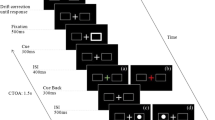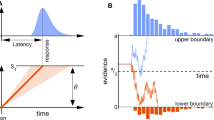Abstract
We propose two explicit mechanisms contributing to oculomotor inhibition of return (IOR): sensory and motor. Sensory mechanism: repeated visual stimulation results in a reduction in visual input to the superior colliculus (SC); consequently, saccades to targets that appear at previously stimulated retinotopic locations will have longer latencies than those that appear at unstimulated locations. Motor mechanism: the execution of a saccade results in asymmetric activation in the SC; as a result, saccades that reverse vectors will have longer latencies than those that repeat vectors. In the IOR literature, these two mechanisms correspond to IOR effects observed following covert exogenous orienting and overt endogenous orienting, respectively. We predict that these two independent mechanisms will have additive effects, a prediction that is confirmed in a behavioral experiment. We then discuss how our theory and findings relate to the oculomotor IOR literature.









Similar content being viewed by others
Notes
One could always use two differential equations to approximate this input reduction, but we chose to use the alpha function for simplicity.
One might suggest that this mechanism should not be regarded as a contributor to IOR because the forward facilitation it generates (saccade momentum) causes a disadvantage for return saccades. Although such a suggestion has merit, so too does our maintenance of the IOR terminology. Our previous modeling papers (Satel et al. 2011; Wang et al. 2011) have addressed two extreme situations where the behavioral effects had been, by convention in the field, labeled as IOR: (1) covert orienting where IOR is elicited by uninformative peripheral cues while the participant maintains fixation until target presentation; (2) overt orienting where IOR is used to label longer latencies for saccades returning to previously fixated locations (e.g., Klein and MacInnes 1999). We prefer to continue to use “IOR” to label both cases because we are following the “convention” in the field where IOR is used to loosely refer to a set of processes that facilitate orienting to novelty. The importance of our contribution rests not on terminology but on the computationally explicit nature of the sensory and motor mechanisms we have proposed to implement these processes.
Readers may be surprised that the saccade back to the central fixation was no slower than the one to the peripheral box (in response to the cue) in the M task. It should be noted that unlike saccades to the targets of which the direction was unpredictable, saccades made in response to the cue-back signal were always directed to the central box.
Although the conceptual underpinning seems quite different (rooted as it is in the notion of cue-target integration) Lupianez’s proposal of a cue-induced “onset detection cost” (Lupiáñez 2010; see also Hu et al. 2011) shares quite a few properties with this suppression effect that is fundamental to our sensory mechanism.
References
Abrams RA, Dobkin RS (1994) Inhibition of return: effects of attentional cueing on eye movement latencies. J Exp Psychol Hum Percept Perform 20:467–477
Amari S (1977) Dynamics of pattern formation in lateral-inhibition type neural fields. Biol Cybern 27:77–87
Anderson EJ, Rees G (2011) Neural correlates of spatial orienting in the human superior colliculus. J Neurophysiol 106:2273–2284
Bell AH, Munoz DP (2008) Activity in the superior colliculus reflects dynamic interactions between voluntary and involuntary influences on orienting behaviour. Eur J Neurosci 28:1654–1660
Bell AH, Fecteau JH, Munoz DP (2004) Using auditory and visual stimuli to investigate the behavioral and neuronal consequences of reflexive covert orienting. J Neurophysiol 91:2172–2184
Berlucchi G (2006) Inhibition of return: a phenomenon in search of a mechanism and a better name. Cogn Neuropsychol 23:1065–1074
Dodd MD, Van der Stigchel S, Hollingworth A (2009) Novelty is not always the best policy: inhibition of return and facilitation of return as a function of visual task. Psychol Sci 20:333–339
Dorris MC, Taylor TL, Klein RM, Munoz DP (1999) Influence of previous visual stimulus or saccade on saccadic reaction times in monkey. J Neurophysiol 81:2429–2436
Dorris MC, Klein RM, Everling S, Munoz DP (2002) Contribution of the primate superior colliculus to inhibition of return. J Cogn Neurosci 14:1256–1263
Dorris MC, Olivier E, Munoz DP (2007) Competitive integration of visual and preparatory signals in the superior colliculus during saccadic programming. Journal Neurosci 27:5053–5062
Dukewich KR (2009) Reconceptualizing inhibition of return as habituation of the orienting response. Psychon Bull Rev 16:238–251
Fecteau JH, Munoz DP (2005) Correlates of capture of attention and inhibition of return across stages of visual processing. J Cogn Neurosci 17:1714–1727
Fecteau JH, Munoz DP (2006) Salience, relevance, and firing: a priority map for target selection. Trends Cogn Sci 10:382–390
Fecteau JH, Bell AH, Munoz DP (2004) Neural correlates of the automatic and goal-driven biases in orienting spatial attention. J Neurophysiol 92:1728–1737
Gore JL, Dorris MC, Munoz DP (2002) Time course of a repetition effect on saccadic reaction time in non-human primates. Arch Ital Biol 140:203–210
Hilchey M, Klein RM, Ivanoff J (2011) In: Annual meeting of vision sciences society. Perceptual and motor IOR: components or flavours? Naples, Florida
Hooge ITC, Frens MA (2000) Inhibition of saccade return (ISR): spatio-temporal properties of saccade programming. Vis Res 40:3415–3426
Hooge ITC, Over EAB, van Wezel RJA, Frens MA (2005) Inhibition of return is not a foraging facilitator in saccadic search and free viewing. Vis Res 45:1901–1908
Hu FK, Samuel AG, Chan AS (2011) Eliminating inhibition of return by changing salient nonspatial attributes in a complex environment. J Exp Psychol Gen 140:35–50
Huber DE (2008) Immediate priming and cognitive aftereffects. J Exp Psychol Gen 137:324–347
Klein R (1988) Inhibitory tagging system facilitates visual search. Nature 334:430–431
Klein RM, Hilchey M (2011) Oculomotor inhibition of return. In: Liversedge S, Gilchrist I, Everling S (eds) The Oxford handbook of eye movements. Oxford University Press, London, pp 471–492
Klein RM, Macinnes JW (1999) Inhibition of return is a foraging facilitator in visual search. Psychol Sci 10:346–352
Klein RM, Taylor T (1994) Categories of cognitive inhibition with reference to attention. In: Dagenbach D, Carr TH (eds) Inhibitory processes in attention, memory and language. Academic Press, New York, pp 113–150
Klein RM, Munoz DP, Dorris MC, Taylor TL (1998) Inhibition of return in monkey and man. Unpublished manuscript
Lupiáñez J (2010) Inhibition of return. In: Nobre K, Coull JT (eds) Attention and time. Oxford University Press, Cambridge, pp 17–34
Macinnes JW, Klein RM (2003) Inhibition of return biases orienting during the search of complex scenes. Sci World J 3:75–86
Masson MEJ, Loftus GR (2003) Using confidence intervals for graphically based data interpretation. Can J Exp Psychol 57:203–220
Mathôt S, Theeuwes J (2011) Gradual remapping results in early retinotopic and late spatiotopic inhibition of return. Psychol Sci 21:1793–1798
Maylor EA, Hockey R (1985) Inhibitory component of externally controlled covert orienting in visual space. J Exp Psychol Hum Percept Perform 11:777–787
Munoz DP, Wurtz RH (1993) Fixation cells in monkey superior colliculus. I. Characteristics of cell discharge. J Neurophysiol 70:559–575
Munoz DP, Wurtz RH (1995a) Saccade-related activity in monkey superior colliculus. I. Characteristics of burst and buildup cells. J Neurophysiol 73:2313–2333
Munoz DP, Wurtz RH (1995b) Saccade-related activity in monkey superior colliculus. II. Spread of activity during saccades. J Neurophysiol 73:2334–2348
Munoz DP, Fecteau JH, J. Hyona DPM (2002) In: The Brain’s eye: Neurobiological and clinical aspects of oculomotor research. Vying for dominance: dynamic interactions control visual fixation and saccadic initiation in the superior colliculus. Elsevier, pp 3–19
Patel SS, Peng X, Sereno AB (2010) Shape effects on reflexive spatial selective attention and a plausible neurophysiological model. Vis Res 50:1235–1248
Pertzov Y, Zohary E, Avidan G (2011) Rapid formation of spatiotopic representations as revealed by inhibition of return. J Neurosci 30:8882–8887
Posner MI, Cohen Y (1984) Components of visual orienting. In: Bouma H, Bouwhuis DG (eds) Attention and performance. Erlbaum, Hillsdale, pp 531–556
Posner MI, Rafal RD, Choate LS, Vaughan J (1985) Inhibition of return: neural basis and function. Cogn Neuropsychol 2:211–228
Prime DJ, Ward LM (2006) Cortical expressions of inhibition of return. Brain Res 1072:161–174
Rafal R, Egly R, Rhodes D (1994) Effects of inhibition of return on voluntary and visually guided saccades. Can J Exp Psychol 48:284–300
Samuel AG, Kat D (2003) Inhibition of return: a graphical meta-analysis of its time course and an empirical test of its temporal and spatial properties. Psychon Bull Rev 10:897–906
Satel J, Wang Z, Trappenberg TP, Klein RM (2011) Modeling inhibition of return as short-term depression of early sensory input to the superior colliculus. Vis Res 51:987–996
Smith TJ, Henderson JM (2009) Facilitation of return during scene viewing. Vis Cogn 17:1083–1108
Smith TJ, Henderson JM (2011a) Does oculomotor inhibition of return influence fixation probability during scene search? Atten Percept Psychophys 73:2384–2398
Smith TJ, Henderson JM (2011b) Looking back at Waldo: oculomotor inhibition of return does not prevent return fixations. J Vis 11(1):1–11, art no 3
Snyder JJ, Kingstone A (2000) Inhibition of return and visual search: how many separate loci are inhibited? Percept Psychophys 62:452–458
Sternberg S (1967) Two operations in character recognition: some evidence from reaction-time measurements. Percept Psychophys 2:45–53
Taylor TL, Klein RM (1998) On the causes and effects of inhibition of return. Psychon Bull Rev 5:625–643
Taylor TL, Klein RM (2000) Visual and motor effects in inhibition of return. J Exp Psychol Hum Percept Perform 26:1639–1656
Tipper SP, Weaver B, Jerreat LM, Burak AL (1994) Object-based and environment-based inhibition of return of visual attention. J Exp Psychol Hum Percept Perform 20:478–499
Trappenberg TP, Dorris MC, Munoz DP, Klein RM (2001) A model of saccade initiation based on the competitive integration of exogenous and endogenous signals in the superior colliculus. J Cogn Neurosci 13:256–271
Wang Z, Klein RM (2010) Searching for inhibition of return in visual search: a review. Vis Res 50:220–228
Wang Z, Satel J, Trappenberg TP, Klein RM (2011) Aftereffects of saccades explored in a dynamic neural field model of the superior colliculus. J Eye Mov Res 4:1–16
Watanabe K (2001) Inhibition of return in averaging saccades. Exp Brain Res 138:330–342
Wilson HR, Cowan JD (1973) A mathematical theory of the functional dynamics of cortical and thalamic nervous tissue. Biol Cybern 13:55–80
Acknowledgments
We are grateful to Juan Lupiáñez, Matthew Hilchey and two anonymous reviewers for their constructive comments and suggestions on an earlier version of this paper. Z. Wang was supported by China Scholarship Council (CSC); R. M. Klein was supported by Natural Sciences and Engineering Research Council of Canada (NSERC).
Author information
Authors and Affiliations
Corresponding author
Rights and permissions
About this article
Cite this article
Wang, Z., Satel, J. & Klein, R.M. Sensory and motor mechanisms of oculomotor inhibition of return. Exp Brain Res 218, 441–453 (2012). https://doi.org/10.1007/s00221-012-3033-8
Received:
Accepted:
Published:
Issue Date:
DOI: https://doi.org/10.1007/s00221-012-3033-8




